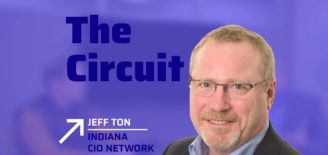FCC looks to Indiana to set national 5G standards
Indiana has been on the cutting edge of telecommunications policy for more than a decade, but the wireless broadband bills passed in 2017 and 2018 set the stage for yet another Indiana first! Senate Bill 213 and House Bill 1050 were both passed by Indiana’s state legislature, making Indiana one of the first states to pass small cell legislation and garnering attention from the FCC and telecom giants AT&T and Verizon.
“One year after enacting Indiana’s small cell bill, the results are in and they’re remarkable,” said FCC Commissioner Brendan Carr. “State leaders reformed the law, so wireless providers have built over a thousand new small cells so far in over 30 communities across the Hoosier state. As I mentioned, not one, but two of the country’s largest wireless providers [AT&T and Verizon] have announced Indianapolis as their showcase city for 5G with deployments happening here by year’s end. That makes Indianapolis, not New York, not San Francisco, that makes Indianapolis number one in the country for most intensive 5G investment. When it comes to wireless, Indiana is the future and that’s because of this state’s innovative leadership.”
FCC Commissioner Carr joined several political and corporate representatives at the Indiana Statehouse on Tuesday, September 4, to announce a proposal for national regulations around the tech responsible for 5G. Indiana’s small cell laws and regulations will help create the template for national regulations.
“We’re excited to be the first city in the country with 5G implementation by both AT&T and Verizon before the end of the year,” said TechPoint CEO Mike Langellier. “We’re entering a new era, one where not only do we access the internet, but so do many of the physical objects that we use every day. …Infrastructure is an important foundation to make that vision a reality. We welcome companies, entrepreneurs, innovators to come build upon it and be part of this tech ecosystem of which we’re so proud.”
According to Bill Soards, president of AT&T Indiana, most cities are still focused on fiber, which is already abundant in Indianapolis. “I think our competitive advantage in Indiana is wireless networks,” Soards said. “We have wireless networks now that other cities are only hoping to get in a few years. By the end of this year, Indianapolis will have two 5G networks and every other city in America is going to have to wait until mid- to late-2019 to have anything like what’s happening here.”
Serial entrepreneur, investor, and current CEO of Lumavate, Mark Hill, believes Indiana’s leadership in 5G will provide a competitive advantage for growing tech companies. Lumavate is at the forefront of the Progressive Web Apps revolution that offers users the advantages of native apps in easy-access web experiences.
“I think access to this kind of speed and performance gives our engineers the opportunity to work first-hand in the real-world environment, and in the tech world, you always want to experience it like the customer before you take it to market,” Hill said. “If you think about consumers and the way we use mobile devices, we have become so impatient. What 5G can mean for companies like Lumavate in the grocery store and other retail aisles is the difference between an experience loading in one or two seconds versus eight or nine seconds and the customer giving up.”
Soards said companies like Lumavate with its progressive web apps and ClearObject and other Internet of Things (IoT) companies communicating with devices all around us are going to feel like they are on steroids when the new 5G networks from AT&T and Verizon both go live later this year.
“By taking your ideas nationwide, we help ensure that every community in our country is 5G ready and that will make a difference to American jobs and families,” said FCC Commissioner Carr. “In fact, an economic analysis released last week suggests that this FCC decision based, in part, on Indiana reforms would cut about $2 billion in red tape, stimulate $2.5 billion in additional investment and create 27,000 new jobs.
“According to the analysis, 2 million more homes will be reached by small cells as a result of this proposed decision, and 97 percent of those will be in rural and suburban communities. Forward-looking policies can bring next-gen networks to people that might otherwise miss out on the opportunity that broadband enables. You prove that here in Indiana.”
Learn how Indiana is taking initiative in other ways to build a friendly business climate for future tech.






































